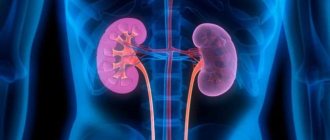Features of the pathology
Click to enlarge
Chronic lymphocytic leukemia appears as an oncological lesion of the hematopoietic system. Among healthy blood cells, atypical ones arise, which have an altered structure and do not function properly. Gradually, such cells multiply and replace healthy ones, settling in various organs. In addition, as a result of the displacement of normal cells by atypical cells, the body's defenses are reduced.
The disease progresses gradually . The first clinical manifestations usually appear already in the last stages, when there are proportionately more altered cells than healthy ones. Initially, CLL is detected only during a typical CBC. An increase in leukocytes is detected due to an increase in the number of lymphocytes.
In a healthy person, B lymphocytes develop in several stages, the final of which is the formation of plasma cells. With CLL, the process does not reach the final stage. Atypical lymphocytes are concentrated in the hematopoietic organs.
The disease is characterized by a slow progression. CLL is the most common form of malignant hematopoietic problems. The prevalence is 3 to 4 people per 100,000 people. In older people, this figure is higher and equals 20-50 cases per 100,000 elderly citizens. Geographically, chronic lymphocytic leukemia, which usually has no obvious symptoms at an early stage, is usually diagnosed in Europeans.
CLL occurs quite rarely in people under 35 years of age. It has a low degree of malignancy, but significantly affects the functioning of the immune system and often provokes the appearance of secondary malignant neoplasms. Most often, people aged 50 to 70 years suffer from manifestations of the pathology (in 70% of cases).
Signs of the disease
Photo taken from present5.com
At first, the manifestations of chronic lymphocytic leukemia are almost invisible. Most often, the pathology proceeds for years without an obvious clinical picture, but even then the following changes in blood composition are detected: the number of leukocytes reaches the upper limit of normal values. Early signs of the disease are nonspecific.
As the pathology progresses, the following symptoms appear:
- lymph nodes are affected - they enlarge, become dense, and remain painless;
- there is an enlargement of the liver and spleen, accompanied by the appearance of heaviness and pain in the lateral areas;
- changes in blood composition occur;
- loss of previous immunity occurs. Diseases that are mild in healthy people are usually long-lasting and lead to complications;
- autoimmune negative consequences occur that can lead to a hemolytic crisis.
Stages of chronic lymphocytic leukemia
Doctors divide chronic lymphocytic leukemia depending on the stage of development of the disease. The generally accepted classification is the degree of damage A, B and C. In the first two stages, pathogenic changes affect only the lymphatic fields, in the third - changes occur in the chemical composition of the blood. The most popular classification is that adopted by RAI, which distinguishes the following stages:
- Stage 0 – the number of lymphocytes in the blood increases to 15*109/l, in the bone marrow they occupy about 40%.
- Stage 1 – the previously appeared changes are supplemented by enlarged lymph nodes.
- Stage 2 – The liver and spleen begin to rapidly enlarge.
- Stage 3 – changes are complemented by anemia.
- Stage 4 – pathogenic changes contribute to a decrease in the level of platelets in the blood.
Manifestation of advanced lymphocytic leukemia
Diagnostics
It is not difficult to identify chronic lymphocytic leukemia, but it can be difficult to distinguish from other lymphoproliferative neoplasms. The doctor takes into account your medical history. The main diagnostic methods are:
- UAC. The growth of lymphocytes in the blood is detected to be more than 5 × 109/l. Lymphocytes replace other cells of the formula. In the final stages, anemia and thrombocytopenia are detected.
- Myelogram showing red bone marrow cells being replaced by lymphoproliferative tissue.
- Biochemistry of blood. In later stages, hypoproteinemia and hypogammaglobulinemia are detected.
- Immunophenotyping. Specific markers of the chronicle are detected. lymphocytic leukemia.
Click to enlarge
To definitively confirm the diagnosis, the following are used:
- biopsy of the lymph node with further sending of the material for histology;
- cytogenetic study;
- Ultrasound of immune links;
- CT.
Specific changes in blood tests are considered the main sign of lymphocytic leukemia. At the beginning, the number of leukocytes increases (more than 5*109/l), with lymphocytes making up 80-90%. As the disease progresses, anemia becomes apparent. Thrombocytopenia is characteristic of the last stage of pathology, when almost all of the bone marrow is filled with atypical cells. ESR is elevated at all stages of CLL.
Forms of chronic lymphocytic leukemia
The following clinical and laboratory forms of the disease are distinguished:
- benign form. The course of the disease is characterized by enlargement of the lymph nodes and spleen, and late development of complications. Patients have a high life expectancy - from 30 to 40 years;
- the classic progressive form is characterized by a rapid increase in the size of the spleen and lymph nodes, as well as the rapid development of leukocytosis. Complications occur earlier, the patient’s life expectancy is reduced to 8 years;
- in the tumor form there is an increase in the size of the lymph nodes;
- splenomegalic – occurs with an enlarged spleen;
- in the bone marrow form, bone marrow damage is observed;
- chronic lymphocytic leukemia, complicated by poisoning of the body as a result of the death of tumor cells;
- tumor cells have villi, so hairy cell leukemia is isolated;
- Japanese residents often have the T-form, mainly in young people. This form is characterized by rapid progression and poor prognosis;
- chronic lymphocytic leukemia, accompanied by the release by cells of protein formations that are absent normally.
In addition, doctors distinguish the phases of the disease:
- phase A, in which an increase in the content of lymphocytes in the blood is recorded without the development of anemia and thrombocytopenia. In this case, there is no enlargement of the lymph nodes, or 1-2 groups are enlarged;
- phase B. The same symptoms are revealed, but 3 or more groups of lymph nodes are enlarged;
- phase C. Anemia or thrombocytopenia is observed, regardless of the enlargement of the lymph nodes.
Chronic lymphocytic leukemia has three stages of development:
- primary, or initial stage. A slight increase in the content of leukocytes in the blood and a slight enlargement of the spleen are detected. The patient is regularly monitored, therapeutic therapy is not required;
- advanced stage of progression. The main symptoms of the disease are expressed. The patient is prescribed specific treatment;
- terminal stage. The development of anemia and thrombocytopenia and other complications (infections, bleeding) are noted. Often a second tumor forms - acute leukemia.
Treatment of pathology
Chronic lymphocytic leukemia is considered an incurable disease, but the quality of life can be significantly improved at any stage. Despite therapy, the pathology will still develop.
In the early stages, no treatment is required. The patient's condition is monitored by a hematologist. Often the patient feels well without the use of medications. Therapy is prescribed only if the disease progresses significantly and complications develop.
The following drugs are usually prescribed:
- Fludarabine. It gives good results, since complete remission can be achieved in many patients. To extend the successful time, additional use of other cytostatics is required.
- Cyclophosphamide. Combines with other drugs to achieve the best results.
- Rituximab. Prescribed in conjunction with other cytostatics, it increases the possibility of achieving complete and long-term remission.
- Chlorambucil. The drug has a targeted effect on the tumor tissue of the lymphatic system, which makes it highly effective.
Various regimens are used to combat cancer. Radiation therapy is required for proliferation of lymphoid tissue, enlargement of the spleen, and for other indications. Used in the final stages of pathology or when conservative therapy is ineffective. If the patient suffers from obvious cytopenia in the CBC, then the spleen is removed.
Sometimes it is useful for the blood in chronic lymphocytic leukemia to use folk recipes. In case of iron deficiency anemia, berries, fruits and vegetables are recommended. Iron, as well as its salts, are found in grapes, garlic, potatoes and other foods. The patient needs to follow a diet - table No. 5.
Treatment
The diagnosis and treatment of lymphocytic leukemia is usually carried out by a hematologist, or less often by a therapist. Treatment of this disease, according to experts, in the early stages of the onset of the disease is not considered appropriate. They are inclined to this conclusion due to the fact that most patients with lymphocytic leukemia at an early stage do not even notice its symptoms. Therefore, drug treatment is not required over a long period of time.
Therapy is prescribed for the most severe symptoms. With a rapid increase in the level of lymphocytes in the peripheral blood, progressive growth of lymph nodes, rapid growth of organs such as the spleen, the appearance of anemia and thrombocytopenia.
Treatment is also required when signs characteristic of tumor intoxication appear. These include:
- excessive sweating at night;
- rapid weight loss;
- a state of constant weakness;
- fever.
Chemotherapy is most often used to treat lymphocytic leukemia. Previously, the main component was chlorobutin, but today preference is given to the most effective purine analogues. Another current solution is bioimmunotherapy using monoclonal antibodies. By introducing these antibodies, specialists provoke the selective destruction of tumor cells, while healthy tissues are not affected.
If the procedures performed do not produce healing results, the doctor prescribes chemotherapy in high dosages, followed by a transplantation of hematopoietic stem cells. In the case when the patient’s tumor mass reaches an impressive size, radiation therapy is used, although as an auxiliary, and not the main one. If the spleen suddenly enlarges, it is recommended to remove the organ.
Nutrition for chronic lymphocytic leukemia
Click to enlarge
In case of illness, the diet is developed by the attending physician. It is recommended to consume a large amount of vegetable protein, foods rich in vitamins and minerals, and adhere to the “Table 5” diet. Your diet should include vegetables and fruits every day. It is important to avoid fatty and fried foods.
With improper nutrition, the patient's condition may worsen, because the organs need to receive useful components. You need to follow the doctor’s recommendations and maintain a competent menu along with taking medications.
Forecast
Life expectancy for chronic lymphocytic leukemia is determined by the stage of the pathology:
- at stage zero, absolute lymphocytosis of 5x109/l is detected, which persists for at least a month - survival rate is 10 years and above;
- at the first stage, absolute lymphocytosis is accompanied by enlarged lymph nodes. Survival typically averages 7 years;
- with CLL grade 2, there is an absolute increase in lymphocytes, and the liver and spleen are enlarged - survival is usually 7 years;
- Stage 3 is characterized by absolute lymphocytosis, in which there is a drop in hemoglobin to less than 100 g/l - survival is most often 1.5 years;
- at stage 4, absolute lymphocytosis is supplemented by thrombocytopenia less than 100×109/l. The average survival rate is close to 1.5 years.
Stages according to the European Binet classification are presented in the table
| Stage | Anemia | Enlarged lymph nodes | Forecast |
| Stage A | Above 100 g/l | In 1-2 regions | Good |
| Stage B | Above 100 g/l | In 3 or more areas | Average (more than 7 years) |
| Stage C | Above 100 g/l | Any number of zones | Bad |
The average survival rate for the disease is 15 years. Richter syndrome occurs in 3-10% of patients. The consequences include neuroleukemia in chronic lymphocytic leukemia, i.e. damage to the nervous system by tumor cells. Has the corresponding symptoms.
Treatment options for CLL are determined by the stage of the disease and include the use of medications, as well as following Diet No. 5.
Blood test for chronic lymphocytic leukemia
Previous post
Causes and treatment of mediastinal lymphadenopathy (mediastinal)
Next entry
Discussion: there is 1 comment
- Natalia:
02/12/2019 at 03:46Why was it called chronic lymphocytic leukemia? It turns out that the disease of the lymph nodes cannot be treated? Some 10 years can be supported and that’s it. Diseases of a genetic nature are usually not treated. Apparently there is a malfunction in the body's immune system.
Answer
General characteristics of lympholeukocytosis
The opinions of many researchers regarding the possible causes of the development of such a disease agree that lymphocytic leukemia is a genetic disease to which children of sick parents are more susceptible. Lymphatic leukemia is not always the primary disease. In some cases, the disease develops during radiation therapy.
There are two forms of the disease lymphocytic leukemia, the signs and symptoms of which will be distinctive. Thus, the acute stage is characterized by the appearance of still immature tumor cells - lymphoblasts. Lymphoblasts are another name for lymphocytes. As such, specific symptoms inherent only in the acute course of the pathology do not exist. The chronic form of the disease is characterized by mature lymphocytes. Chronic lymphocytic leukemia is considered a sluggish, long-term disease.
If lymphocytic leukemia develops, the following symptoms may occur in children and adults:
- a larger change in the size of organs and systems such as the liver, spleen, peripheral lymph nodes;
- increased sweating;
- skin rash;
- increase in general temperature;
- loss of interest in food, weight loss, chronic general malaise;
- muscle weakness, bone pain;
- deterioration of the immune system, penetration of various infections into the body;
- formation of secondary tumors.
It is worth highlighting the main stages of the development of the disease. Thus, at the initial stage, the first signs and symptoms of the disease appear, for the diagnosis of which a person usually turns to a specialist.
The stage of remission, when symptoms subside or completely disappear, is referred to by doctors as complete recovery.
A blood test for lymphocytic leukemia is performed even if the symptoms have completely subsided.
There are also cases where a relapse occurs several years after the disease has been cured. Often, chemotherapy repeated at this time does not bring positive results, and the person simply dies.












